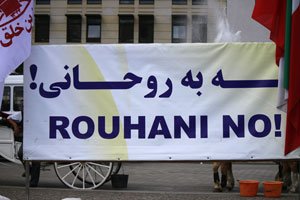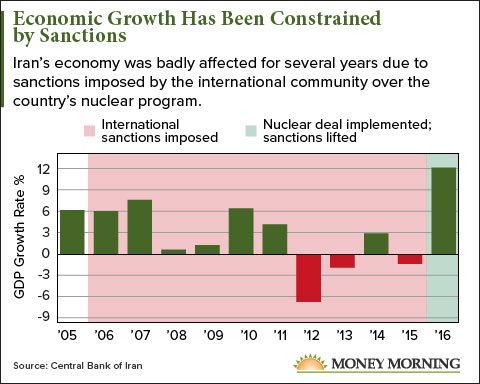Iran's President Hassan Rouhani is on borrowed time.
Even as the recent protests in the country have died down thanks to the deployment of Tehran's national guard, the lingering threat of an uprising remains, largely due to the dismal state of the nation's economy.

Meanwhile, there are myriad external threats that pose a danger to Iran's stability as well - like the United States, which seems ready to end the nuclear deal (JCPOA) and re-impose sanctions on Iran at any moment.
Tehran's precarious situation could only makes oil prices increasingly volatile - leaving many investors wondering where they'll go next.
Here's everything you need to know about the dangerous state of the world's seventh-largest oil producer, and how you can make its volatility work for you...
Iran's Internal Struggles Could Cause a Spike in Oil Prices
The biggest anti-government protests in Iran for nearly a decade have been fueled by rising discontent over President Rouhani's economic policies.
For instance, in 2015, Iran's gross domestic product (GDP) dropped to -1.4%. That same year, President Rouhani agreed with world powers to limit Iran's sensitive nuclear activities in the still-hotly-contested Iran Nuclear Accord.

In 2016, after the deal was implemented, and most of the aggressive sanctions on Iran were lifted, the economy surged back, and the nation's GDP grew 12.3%, according to the Central Bank of Iran. Much of that growth was attributed to the oil and gas industry.
Then, on Dec. 18, 2017, the International Monetary Fund (IMF) said growth had begun to spread to the non-oil sector in Iran, which meant the economic boon was spreading to other industries in the country. It predicted that Iran's GDP would expand by another 4.2% in the 2017/18 fiscal year.
Learn How to Turn $500 into $1 Million: This Sunday school teacher's "retirement career" made him a millionaire. This book will teach you how you can do it too. Claim your FREE copy...
However, despite this momentous growth, the people of Iran are not finding the recovery as significant as they'd hoped.
For one, the unemployment rate in the country is astronomical - 12.4%, according to official data quoted by BBC yesterday. But in some parts of the country, the British media outlet revealed, the Iranian unemployment rate is closer to 60%.
And while inflation has dropped since Rouhani's election in 2015, it's still at 11% - an unaffordable sum for the many Iranians out of work.
Analysts point to the fact that U.S. sanctions on financial transactions with Iran have remained in place, which has deterred foreign companies from doing business there. Add U.S. President Donald Trump's Oct. 13, 2017, refusal to recertify the nuclear deal to the mix, and you'll see how Iran's current situation leaves the fate and wellbeing of its people in limbo.
The protests have garnered a knee-jerk reaction in the oil markets. WTI (West Texas Intermediate, the benchmark crude rate for futures contracts cut in New York) was up nearly 3% in just the first three trading days of 2018.
And if there's any sign that these demonstrations might instigate strikes in the nation's oil fields, oil prices will really take off.
But this is only the beginning of Iran's woes right now...
Iran Is About to Take Several Hits from the Outside World
Tehran's ongoing battle with the Saudis poses another threat to the country's stability.
Saudi Arabia and Iran have long been at loggerheads with one another - especially in their ongoing proxy war in Yemen.
Never miss a single update on oil & gas again. Get real-time alerts sent to your inbox, completely free, here.
So far, however, "most of the political risk has been smaller-scale," Michael Lynch, president of Strategic Energy & Economic Research, told Bloomberg on Nov. 10. "But when you start talking Saudi Arabia and Iran, that gets people's animal spirits flowing."
Like the political demonstrations, Iran's conflict with Saudi Arabia won't necessarily affect oil supply or demand, but the uncertainty and tension continue to inspire bullish oil action.
That very week last fall saw hedge funds and other money managers increasing their bullish bets on crude oil because of the ongoing Saudi Arabia-Iran tensions.
Prices have indeed surged over the past two months - with WTI going from $56.74 on Nov. 8, 2017, to $61.41 today - a market-crushing 8% for that time frame.
However, the most critical event on Iran's horizon won't merely spark short-term increases in the oil price. Rather, this event could send American oil companies downward in the long term.
[mmpazkzone name="in-story" network="9794" site="307044" id="137008" type="4"]
If Washington one day reverses the JCPOA and re-imposes sanctions on Iran, U.S. oil drillers would be hit the hardest.
Money Morning Global Energy Strategist Dr. Kent Moors, an internationally recognized expert in oil and natural gas policy, explained to readers last October that many of the world's biggest oil producers - Russia, China, and even some Persian Gulf parties (Qatar and its banking center in Doha, for example) - still support the Iran deal.
Their prolonged loyalty means they would likely break with Washington if the United States once again imposed sanctions on Iran.
"Iran would still be able to get the needed banking from elsewhere, circumventing any returning U.S. sanctions relatively easily," Kent said.
Additionally, while U.S. oil exports are again reaching levels not seen since the early 1970s, that doesn't mean American crude could replace Iran's in the market.
"At levels approaching 1.5 million barrels a day, the potential for further flexible export capacity for U.S. production is limited," Kent explained. In other words, the United States won't be able to export more oil no matter what's happening in Iran.
OPEC members are more likely to enjoy any opportunities for increased sales. They would have a greater ability to exceed their production cap without depressing overall prices.
Meanwhile, American companies will be left out in the cold, while U.S. sanctions will do little to Iran without the buy-in from allies.
But that doesn't mean investors should be left out in the cold as well...
As Iran becomes more and more unstable, and President Trump continues to threaten an end to the Iran nuclear deal, you need a balanced energy portfolio to reduce volatility and increase total gains.
And this "super fuel" will help you do just that...
The World's First "Universal Fuel"
Physicists have known about an unlimited source of free fuel for over 100 years.
And now, thanks to a stunning breakthrough in chemical engineering, we have the ability to power the entire planet for over 36,000 years.
And the cost of this fuel is zero. It's free. Click here to read more...
Follow Money Morning on Twitter @moneymorning, Facebook, and LinkedIn.


